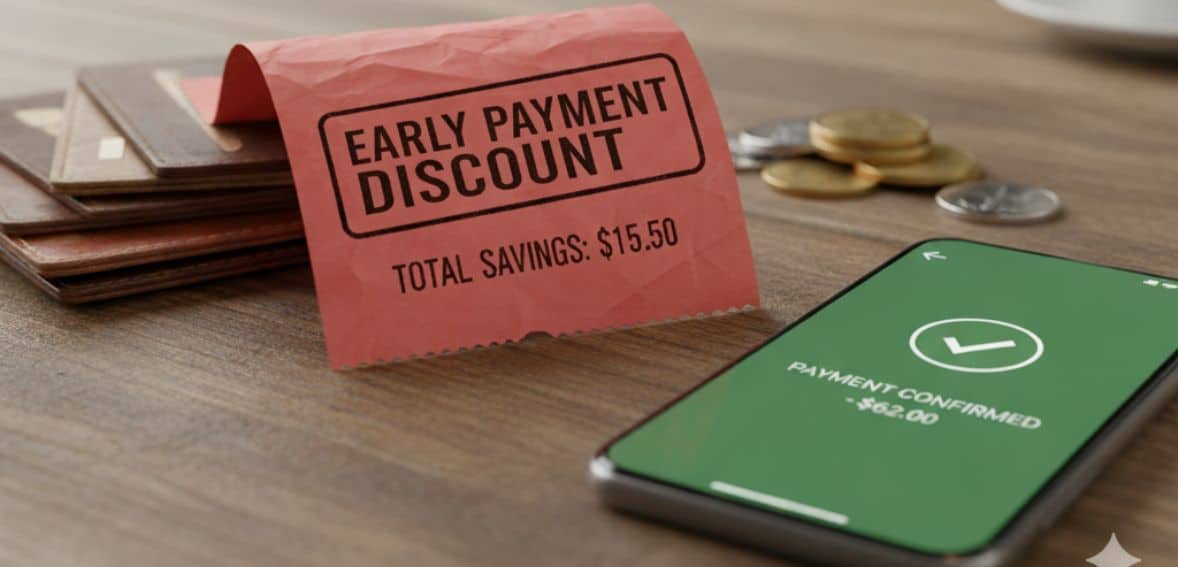
By alphacardprocess September 28, 2025
Early-payment discounts (EPDs) can help in fostering closer relationships with wholesale customers. By providing versatile payment terms and minor rebates for early payment, companies express gratitude, promote loyalty, and establish trust. This incentive aids in the growth of partnerships and long-term cooperation.
What Is an Early Payment Discount (EPD)?
Early payment discount (EPD) is a straightforward method of motivating customers to settle their bills ahead of schedule, according to the agreed terms of payment. In exchange, customers have the opportunity to save a few percentage points on their payment, typically 1% to 2%. For example, if an invoice is marked “2/10,” that indicates the customer can earn a 2% discount if payment is received within 10 days early from the date.
The advantage is not solely to the customer. Consumers save money, and companies enhance cash flow by getting paid quickly. Quick access to cash can be used to pay for operations on a daily basis, less frequently need to borrow, or even fund growth opportunities.
In addition to that, quicker payments reduce a major metric known as days sales outstanding (DSO), which measures how long it takes a company to be paid. A lower DSO indicates a company is well-managed financially and has operations going smoothly.
Types of Early Payment Discounts

Early payment discounts (EPDs) tend to be in three types, static, sliding scale, and dynamic. Each has a varying degree of flexibility, and companies can employ one or a combination based on their requirements.
1. Static EPD
The most basic and prevalent one is the static discount. It provides a specific discount if payment is received within a certain number of days. For instance, a term 2/10 – net 30 on a bill of $2,000 implies that the buyer receives a 2% discount ($40) if paid within 10 days. Otherwise, they pay in full within 30 days. This is a simple model and is frequently applied when companies need to advance their cash position rapidly.
2. Sliding Scale EPD
A sliding scale discount varies based on how soon the customer pays. The sooner the payment, the larger the discount. For example, a $2,000 bill may begin with a 2% discount if paid immediately, but the discount decreases as the days go by. By day 10, it may be 1.33%, by day 15, it may be 1%, and by day 20, it might be 0.67%. This method assists companies in prompting quicker payments during the billing period and maintains cash flow on a regular basis.
3. Dynamic EPD
Dynamic discounting is more adaptable since it provides for negotiation between the buyer and seller. In this case, the terms are not set but negotiated according to needs or situations. For example, a client can request a discount of 1.5% on an invoice of $2,000, and the supplier could agree if payment is received within 15 days. This kind of arrangement is suitable if both parties are seeking a win-win situation and are willing to tailor terms.
How to Calculate Early Payment Discounts

Regardless of the type of early payment discount (EPD) you apply — static, sliding scale, or dynamic — calculating how it works remains the same:
You have a hardware business, and the supplier sends you an invoice of $15,000 with 1/10 – net 30 terms. You can take a discount of 1% if you pay within 10 days or pay the entire amount in 30 days. Here is how to calculate the discount in steps:
Begin with the invoice value and discount rate. In this scenario, $15,000 and 1%.
Convert 1% to decimal form: 1 ÷ 100 = 0.01.
Multiply the total of the invoice by (1 – 0.01): $15,000 × 0.99 = $14,850.
Therefore, if you pay within 10 days, you will only pay $14,850 and not $15,000. The formula for this is:
Discounted price = Original invoice amount × (1 – Discount %)
Or you may calculate it in the following manner:
Discounted price = Original invoice amount – (Original invoice amount × Discount %)
Both approaches result in the same outcome.
Discounts vs. Loans
At times, as a vendor, you might question whether or not offering discounts is preferable compared to borrowing business loans. To make an equivalent comparison, you must compute the discount’s annual percentage rate (APR).
This is how you do it with the same 1/10 – net 30 scenario:
Discount percent = 1% (0.01 in decimal).
Divide discount by (1 – discount): 0.01 ÷ 0.99 = 0.010101.
Calculate the difference between the discount period (10 days) and the full term (30 days): 30 – 10 = 20.
Divide 360 by 20: 360 ÷ 20 = 18.
Multiply step 2 and step 4: 0.010101 × 18 = 18.18%.
Therefore, the APR of this discount is 18.18%.
If the buyer is able to borrow at less than 18.18% interest, it is sensible to borrow and pay up-front to get the discount.
If their savings account is returning less than 18.18% interest, it’s worth paying early and accumulating more than they’d gain by waiting for the money.
Simply put, calculating the APR provides a stark indication of whether the discount is worth it in contrast to borrowing loans.
Strengthen Wholesale Client Relationships with Early Payment Discounts

Benefits for Vendors
Initially, offering customers a discount for paying early may appear to be losing business for the company, but in reality, early payment discounts offer many benefits to sellers. The most significant advantage is faster payments. Discounts encourage customers to pay earlier, lessening the trouble and expense of issuing reminders or pursuing overdue payments.
Quicker payments translate into more productive cash flow, providing companies with additional money to pay bills, invest in expansion, or improve quarterly statements. In addition, providing payment alternatives and discounts fosters a deeper sense of customer loyalty, rewarding buyers and encouraging them to shop again. Lastly, making payments early even saves money in the long term.
Benefits for Customers
Not only do early payment discounts save customers money, but they also produce a more robust, positive relationship between wholesalers and customers. One of the great advantages is offering customers more choices. When customers feel they have a choice in how and when to pay, it empowers them with more control over their money and makes the relationship more collaborative.
Discounts also serve as incentives for good payment behavior. Customers like to be rewarded for paying early, and even a modest saving feels like a victory, leading them to continue working closely with the supplier. Lastly, regular early payments can enable customers to establish stronger business credit, which could potentially lead to improved future payment terms and financing opportunities. Overall, EPDs foster feelings of trust, gratitude, and collaboration that allow wholesalers to keep their customers loyal for the long term.
Disadvantages of Early Payment Discounts
Although early payment discounts are beneficial, they are not without some disadvantages. The most prominent disadvantage is decreased profit. For companies that already operate on thin margins, granting even a 1% or 2% discount eats into earnings.
For instance if a $1,000 order generates $200 profit, a 2% discount reduces profit to $180 — a 10% reduction. Another issue is granting discounts to customers who already pay on time or early. In those situations, the company is giving away money which even though is a small amount days into your profit.
Despite discounts, not all customers will pay ahead of time, and even if they do, they may still differ in the way they make payments. Finally, a loan could sometimes be more financially worthwhile than discounts. If there is low-interest financing available, it might prove to be less expensive than discounting invoice values. That’s why it’s essential to balance the benefits and costs of providing early payment discounts properly.
How to Effectively Implement Early Payment Discounts

Early payment discounts can accelerate cash flow, minimize late payments, and foster greater client relationships, but they demand planning.
Begin by examining your company’s cash flow, business requirements, and possible effects of extending discounts, make definitive objectives such as quicker payments or more secure client loyalty. Secondly, establishing specific and appealing terms for discounting, such as the rate, qualification period, and qualifying terms, always ensures if they are equitable and competitive.
Inform customers of the new policy via invoices, contracts, or personal messages, detailing how they can benefit from it. Alter your billing and accounting systems to accommodate the new terms where possible and automate the calculation to avoid errors. Monitor payments regularly to confirm discounts are applied correctly and track customer adherence to the terms.
Finally, evaluate the program’s effectiveness over time, reviewing its impact on cash flow, payment behavior, and customer relationships, and adjust the terms as needed to maximize benefits
Things to Do Before Adopting Early Payment Discounts
When it comes to discounts, it’s important to clearly understand the payment terms. These discounts are only available if payment is made within the agreed discount time.
After the deadline, the entire invoice has to be paid. To avoid misunderstandings, the terms of the discount must always be clearly expressed in the agreement and on the invoice. As a buyer, you should also carefully read the small print, particularly if you are using credit.
The last thing you wish for is to incur additional expenses and then forego the discount. Keeping good customer and supplier relationships is equally important. Trade discounts are mutually beneficial, but it takes trust and honesty
At times, a buyer may pay in advance for materials that will be delivered weeks or months later. Ensure that the buyer receives the goods on time and stay informed about tracking or shipping of the goods. Lastly, shoppers must make sure they really do have the money in their hands to pay ahead.
Companies should streamline their accounts receivable procedure so their own customer payments arrive on time, and sometimes giving small discounts to accelerate collections is a good idea. Alternatively, one can take out a line of credit that could be utilized for early payments.
Early Payment Discount Alternatives

Early payment discounts are effective for enhancing cash flow, but there are other modern payment options available. Sometimes, giving discounts might not be the best option for all businesses. The following are a few popular alternatives:
1. Invoice Factoring
With factoring, you assign your unpaid bills to a financing company (a factor). You usually receive around 80% of the bill value in a few days. When your customer pays, you get the remaining amount minus the factor’s fee. It’s quick, but the fees need to be considered.
2. Invoice Financing
This is kind of like factoring, but in this case, you borrow money against your outstanding invoices rather than selling them. Your invoices become collateral, but you retain control over your accounts. It’s sometimes referred to as sales-ledger financing.
3. Borrowing a Loan
Occasionally, a conventional loan might be the way to go. If you are eligible for market-driven interest rates and payments are affordable, you can leave invoices at their full amount and instead go for borrowing loans.
Conclusion
Early-payment discounts are a straightforward but powerful weapon for building wholesale client relationships. They promote prompt payment, enhance cash flow, and demonstrate to clients that you appreciate their corporation. By tying financial incentives with open communication and responsive service, wholesalers can create trust, develop loyalty, and establish lasting relationships that work for both parties.
FAQs
What is an early-payment discount (EPD)?
An EPD is a percentage discount on an invoice provided to customers who pay upfront of the agreed due date.
Why is an EPD beneficial for wholesalers?
It accelerates cash flow, minimizes delayed payments, and fosters relationships with long-term customers.
Can customers negotiate early-payment discounts?
Yes, dynamic EPDs enable buyers and sellers to settle on mutually acceptable discount rates.
Do early-payment discounts impact profit?
Although discounts marginally decrease revenue per invoice, the advantages of quicker cash and loyalty frequently outweigh the expense.
Who are the customers who derive the most benefit from EPDs?
Regular, long-term customers who pay promptly save money, obtain improved terms, and receive preferential service by using EPDs.